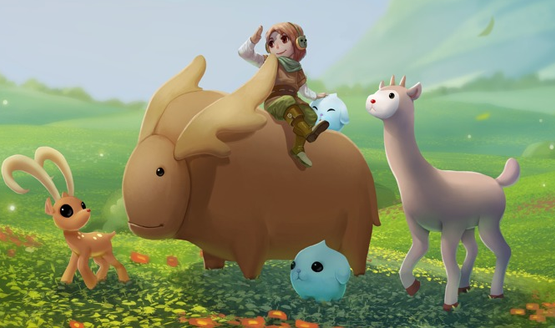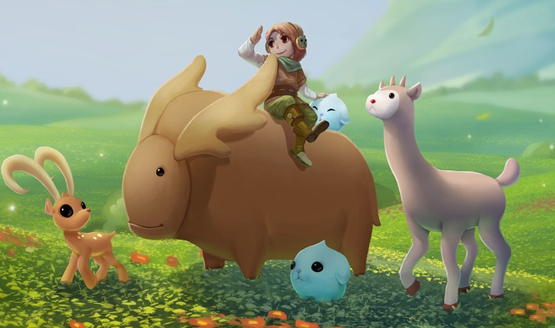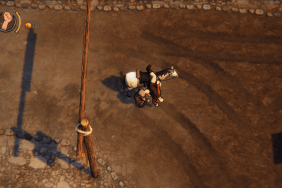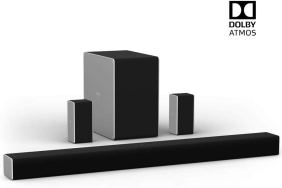PSLS: You were able to essentially create a living ecosystem through sound alone. We never see these bugs or birds. There aren’t a lot of creatures in the world, I think there’s one big animal per biome and then some other little things that skitter on the ground.
Stephan: Right, there are bird models, I think there are seagulls and stuff that fly overhead, and actually there are sounds attached to them that are separate. There are dynamic birds that fly around and have separate sounds that are attached to them, so what you get is a bird in a tree, a bird in a tree, then suddenly [imitates crow] of a crow flying overhead, which adds that next level of dynamics.
This is the thing that surprised me with a tiny development team and myself. I think we did do a really great job of creating a live world. You’ve got the birds overhead moving around, you’ve got the birds in the trees with those emitters, the proximity, the things like Groffles and grass foxes — who all have a different vocabulary as well. They’ve got different sounds when they are sitting around. If you spook them and they run away they’ve got a different sound. They snore. If you feed them and they’re happy, they’ve got a different sound.
We own two cats, and one of the things that I learned very quickly is that everyone who thinks that a dog goes woof and a cat goes meow– my cat’s got a full vocabulary. It can very clearly say to me ‘dude, I’m hungry. Feed me.’ Or it will walk in and say ‘pat me now’ or ‘do not pat me now,’ you know? I think anybody that spends any time around animals, horses, cows, whatever, realizes there are different sounds there.
There are games where there will actually be the equivalent of an NPC that follows you around that’s an animal, whether it’s a dog or a horse or anything like that, and the people spent all the time on this game, and the dog’s got one woof sound. It’s like, come on guys! That just feels– again, someone who is going to play a game and enjoy having a dog character is probably someone who owns a dog in real life. And if you own a dog in real life, you know the range of sounds that dog can make. To just throw in a couple of woof sounds to me is letting down your customers there.
There’s an animal in Yonder that is actually more of a collectible, and that’s the cats. Those are literally just– they have a meow to let you know where they are. You’d be surprised on the reviews on that, people love finding the cats, like ‘Oh my god, the cats are so cute!’ What’s interesting is that I originally put in a whole bunch of cat meows, and they were recordings of one of our cats. Then I thought ‘Well, they’re okay…’ and these are full size cats in the game, but I though ‘I think I want to change it.’ I swapped it out to recordings I made years ago of when our cat was a kitten, so then it was kitten meows, and it made so much of a difference. Everyone was like ‘Oh no! There’s a kitten somewhere, I’ve got to save it!’
PSLS: And then they purr!
Stephan: Exactly! I was like, I need a sound for when you– initially, often in game development, you just do a placeholder sound. So you just do a sound that lets you know that you’ve done a thing, and later I will add something else. Originally we just had a placeholder sound for the kitten that was just this ‘Ding!’ and you’ve captured a kitten. I was thinking ‘What can I do? What can I do?’
Then one day I was holding my cat and it just started purring, and I thought ‘Oh, that’s perfect!’ and I had recordings of purring. I’ve read reviews of people that have gone ‘It is so amazing! You pick up the cats and then they purr!’ and it feels so rewarding. There are no visuals in this. It’s all sound. The reward for picking up a cat is that you get to hear a purr, and I have been amazed at how many people have loved that. They get the purr sound and they go ‘Yay! I saved a kitten!’ and they feel so good about it because of this purr sound. We all associate the sound of a purring cat with ‘I’ve done something right, I’ve got a happy cat.’ That’s a good thing.
This is actually often the role of audio that people often don’t understand. Audio has sort of one task, and I’m talking music and sound design. Our task is to support the narrative, to make sure the story is told as best as possible. Sometimes we can tell the story better with just sound. There was a demo I worked on years ago, it was a PlayStation 2 game, and we had done this demo level. We got right to the end and somebody went ‘Oh no, this is terrible! In the video we did before we did this demo, there was a helicopter, and we haven’t put the helicopter in!’ Everybody was panicking because we crammed everything we could possibly cram into this game demo. We didn’t have any memory left to put a helicopter in.
I said ‘It’s fine, I’ve got this covered,’ and they were like ‘What, how have you got it covered?’ I basically went and I had a tiny bit of memory left, and I compressed the sound which would then be stretched to sound like a helicopter, and it was just a little loop — helicopters conveniently loop quite well. Then I told one of the programmers to just put it on an invisible track flying around the outside of this area, and the area was like a car park of like a Walmart or something. I basically had it flying slowly around the edge, and we put it in.
One of the bosses said ‘That’s no good! All we’ve got is the sound of a helicopter. That’s terrible. That doesn’t solve our problem,’ and I grabbed him and dragged him outside of the studio to the street and said ‘Okay, what can you hear?’ He said ‘I can hear cars.’ ‘What else?’ ‘I can hear a jet airliner, and airplane flying overhead,’ and I said ‘Cool, where is it?’ and he looks up and ‘Uhhh, I don’t know.’ Exactly. It’s probably behind the clouds or behind a building, but as soon as you can hear a helicopter or a truck or a train, if you look around and you don’t see it, you don’t think that the helicopter doesn’t exist. Your brain just says it’s behind that building over there, or it’s up in the clouds or whatever. And he looked at me and said ‘Okay, that works.’
Quite often we can literally tell the story. Like I can have the sound of a steam train whistle on the other side of the hill, and maybe that’s a hill that you can never walk over, but it’s like there’s a steam train somewhere. I’ve just added a whole new narrative, an entire world, we now know that there’s trains in the world. We know that there’s trains locally. I can make it so the sounds triggers once a day or once a week, and so suddenly the story now says ‘there’s a train that comes through this region once a week.’ We haven’t built a train, we haven’t had to do anything. We just added a sound and all of a sudden the story has this entire element of the world having trains that run through this region on a timetable, and that’s all been done with one sound.
There’s some fun things you can do with just sound.
PSLS: And it seems like you did quite a bit of that with Yonder, with building out that living world and pursuing their narrative, direction, and style. Thank you for taking the time to talk audio design with us. I learned a lot and it has been a pleasure!
Stephan: Thank you very much!
PlayStation LifeStyle would like to thank Stephan for taking the time to talk to us about Yonder’s audio design. Yonder is available now, and our review can be read here.









